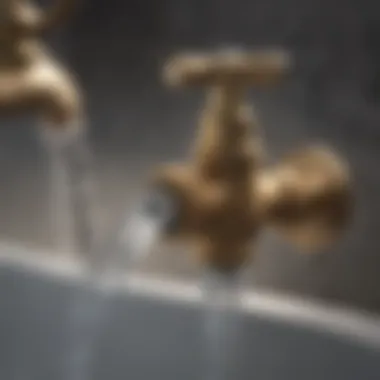Understanding Hard and Soft Water: Key Differences Explained


Intro
Water is an integral component of life, impacting both human health and daily activities. Understanding the differences between hard and soft water is essential for navigating various concerns, from plumbing issues to health impacts. As water quality varies significantly across regions, it is crucial to comprehend the implications of these differences.
Hard water contains a high concentration of minerals, especially calcium and magnesium, which can create challenges. Soft water, on the other hand, undergoes processes that reduce these minerals, leading to a different set of effects. This article will delve into the specifications and relevance of both water types, emphasizing their importance to households, health, and the environment.
Fascinating Facts About Water
- Hard Water Composition: Hard water typically has a mineral content that exceeds 60 mg/L. It often leads to scaling in pipes and appliances.
- Soft Water Generation: Soft water is often produced through ion-exchange systems. These systems replace calcium and magnesium ions with sodium or potassium ions.
- Health Considerations: Some studies suggest hard water may contribute to higher dietary calcium and magnesium intake, potentially benefiting cardiovascular health.
While soft water can lead to more effective soap use, hard water may offer certain mineral benefits that are important.
Implications of Hard and Soft Water
Effects on Household Activities
- Plumbing: Hard water can lead to mineral buildup in pipes, reducing water flow and efficiency.
- Appliances: Appliances, such as dishwashers and water heaters, can suffer from reduced lifespan due to scaling from hard water.
- Cleaning Efficiency: Soft water often enhances the effectiveness of soaps and detergents, requiring less product for similar results.
Health Impacts
- Mineral Intake: The minerals in hard water, while sometimes seen as beneficial, can also be a concern for individuals on low-sodium diets.
- Taste and Preference: Some people prefer the taste of hard water, citing its mineral content as a flavor enhancement.
Environmental Considerations
- Wastewater Management: The ion-exchange processes used to soften water can contribute to wastewater concerns if not managed properly.
- Conservation: Choosing appropriate water types for various uses can impact overall resource conservation.
Finale
Understanding the differences between hard and soft water is not merely an academic exercise; it has practical implications for health, household management, and environmental sustainability. As we navigate the complexities of water quality, acknowledging these distinctions will guide more informed decisions that resonate through our daily lives.
Preamble to Water Types
Water is a vital resource, impacting many aspects of daily life and environmental health. This section introduces two primary types of water—hard and soft water—investigating their definitions and significance. Understanding these differences is essential for various audiences including homeowners, veterinarians, and biologists, as the mineral content in water can have profound effects on health and functionality.
Defining Hard Water
Hard water is characterized by a higher concentration of dissolved minerals, particularly calcium and magnesium. These minerals primarily originate from geological formations that the water passes through before reaching residential systems. As a result, hard water can vary greatly based on local geology.
Some key points about hard water include:
- Scale Formation: When hard water is heated, it can precipitate scale, leading to buildup in pipes and appliances.
- Soap Efficiency: Hard water reacts with soaps, making them less effective. This can cause increased soap usage for washing and cleaning.
- Impact on Health: While hard water has been questioned in terms of health impacts, some studies suggest it may provide beneficial minerals in small amounts.
The understanding of hard water’s characteristics is important for families and households since it necessitates varying approaches to home maintenance, ultimately affecting the cost and longevity of plumbing systems.
Defining Soft Water
Soft water, on the other hand, contains fewer dissolved minerals. It is often achieved through processes such as ion exchange. This results in water that is gentler on surfaces, equipment, and skin. Soft water is typically preferred for those concerned with the effects of hard water.
Key characteristics include:
- Taste: Many find soft water tastes better due to lower mineral content. This can be particularly relevant for families who prioritize drinking water quality.
- Skin and Hair Care: Soft water may be beneficial for skincare and hair health, as it can help prevent dryness and irritation.
- Reduced Maintenance: Homes using soft water often experience less scaling on plumbing fixtures and appliances, leading to decreased maintenance needs.
Understanding the distinction between hard and soft water empowers individuals to make informed choices regarding water quality based on personal preference and health considerations. Both types of water play a significant role in ecological and household impact.
Chemical Composition of Water
The chemical composition of water is critical in distinguishing between hard and soft water, as it underlies the fundamental differences that affect both health and household activities. Specifically, these compositions are defined primarily by the types and concentrations of minerals present in the water. Understanding these compositions helps in assessing how water quality influences plumbing systems, appliances, and even the physiological well-being of humans and pets alike.
- Hard water contains higher concentrations of minerals like calcium and magnesium.
- Soft water, on the other hand, generally has lower levels of these minerals and often includes higher sodium content.


Ultimately, the chemical composition of water influences not only daily tasks but also long-term environmental impacts, making it an essential area of study.
Minerals in Hard Water
Calcium
Calcium is one of the dominant minerals found in hard water. Its presence is significant due to its role in both plumbing and health. This element contributes to the overall hardness of water, which can lead to certain drawbacks in household settings. One key characteristic of calcium is its ability to form scale deposits in pipes and appliances. These deposits can decrease water flow and efficiency over time, affecting devices like dishwashers and water heaters.
However, calcium is also an essential nutrient for human health, particularly for bone health and metabolic functions. Therefore, its dual role is complex.
Some advantages of calcium in hard water include:
- Natural supplementation through water intake.
- Contribution to the dietary calcium needs of individuals, especially in regions with low dietary sources.
On the downside, excessive calcium can lead to increased maintenance costs for household systems and potential health concerns when consumption occurs in excessive amounts.
Minerals in Soft Water
Sodium
Sodium is the primary mineral found in soft water, often introduced through water softening processes. This mineral alters the overall composition of water, creating a distinctive profile compared to hard water. One critical aspect of sodium is its role in enhancing the efficiency of soap and other cleaning agents. It reacts well with these compounds, leading to increased lather and cleaning power.
A key characteristic of sodium is that it typically does not produce scale. Thus, appliances and plumbing systems are less likely to endure wear and tear attributed to mineral build-up.
However, the unique feature of sodium comes with its own considerations:
- Higher sodium levels in drinking water, which may concern certain individuals, especially those on sodium-restricted diets.
- Perception of taste may vary; some people find soft water to taste slightly salty compared to hard water.
Both hardness and softness in water raise essential points for families and pet owners to consider. The interplay of these minerals shapes not only the experience in household activities but also the broader implications for health and lifestyle choices.
Factors Influencing Water Hardness
Understanding water hardness involves examining various elements that contribute to its level. Recognizing these factors is crucial because they affect not only household plumbing and appliance efficiency, but also the overall health of those who consume this water. By analyzing these factors, we can grasp how hard or soft water can impact our daily lives and the environment.
Geological Impact
The geology of a region plays a significant role in determining the hardness of water. Water interacts with the minerals found in the earth as it moves through soil and rock formations. For instance, areas with limestone or gypsum deposits tend to yield hard water. This is because these minerals dissolve into the water, increasing its calcium and magnesium content.
In contrast, regions dominated by granite or basalt may produce softer water. The difference in mineral composition directly influences local water quality. Residents in areas with hard water often encounter challenges such as scale buildup in pipes, which can lead to costly plumbing issues. Additionally, the reactive nature of hard water can affect the functioning of appliances such as dishwashers and washing machines, leading to inefficiencies and higher energy bills.
Water Source Considerations
The source of water significantly contributes to its hardness. Surface water, sourced from lakes and rivers, generally has lower mineral content than groundwater, which often percolates through mineral-rich rock layers. For example, municipal water supplied from wells is frequently harder than that from surface sources.
In regions where groundwater is the primary source, home residents may need to consider treatment options. This is particularly important for families with children or pets, as hard water can lead to skin irritations and other physiological impacts. Additionally, the extraction process and treatment methods used by local water suppliers can also affect water hardness levels.
Understanding the relationship between geological characteristics and water sources can guide individuals in making informed decisions about water treatment options.
Hard and soft water not only influence household utility but also impact health, emphasizing the importance of understanding local geological and water sourcing traits.
Impacts of Hard Water
Understanding the impacts of hard water is essential for many sectors, from household maintenance to health considerations. Hard water contains a high level of minerals, mainly calcium and magnesium. These minerals can significantly affect a variety of systems in a home and even human health. It is important to analyze the direct effects of hard water on plumbing, appliances, and overall well-being.
Effects on Plumbing Systems
Scale Buildup
Scale buildup is one of the most noticeable impacts of hard water on plumbing systems. This accumulation occurs when dissolved minerals precipitate out of the water and onto plumbing fixtures, pipes, and appliances. Over time, this mineral layer can narrow pipes and obstruct water flow, leading to increased pressure and potential leaks.


The key characteristic of scale buildup is its ability to create stubborn deposits that are difficult to remove. This makes it a significant concern in areas with hard water. A well-informed audience should recognize that addressing scale buildup can prevent costly repairs down the line.
Some of the disadvantages of scale buildup include its impact on energy efficiency. When minerals coat the heating elements in water heaters and other appliances, it requires more energy to heat water. This can increase energy costs and reduce the lifespan of appliances.
Impact on Appliances
Water Heaters
Water heaters are among the household appliances most affected by hard water. The mineral deposits form on the heating elements, leading to reduced heating efficiency. This can result in longer wait times for hot water and increased energy expenditures.
A critical feature of water heaters in hard water environments is their need for regular maintenance. The built-up scale must be periodically flushed away to maintain optimal performance. Families dealing with hard water should consider this essential aspect in their appliance management. Failure to do so can lead to decreased efficiency and a shorter lifespan for the heater.
Health Considerations
Health considerations surrounding hard water often relate to its mineral content. While minerals like calcium and magnesium are essential for human health in moderate amounts, excessive quantities can lead to issues. Some individuals may experience skin irritation or other dermatological problems, especially if the water is excessively hard.
Ultimately, understanding the impacts of hard water is vital for making informed choices about water treatment options. Awareness can help to mitigate potential plumbing problems, appliance inefficiencies, and health-related concerns.
Advantages of Soft Water
Soft water offers several advantages that are essential to understand when comparing water types. The shift from hard to soft water can have significant implications for households, plumbing systems, and personal care routines. Understanding these advantages is vital for anyone considering the quality of water in their daily lives.
Gentler on Plumbing
Soft water is less abrasive than hard water. This characteristic stems from the lower mineral content, particularly calcium and magnesium. The absence of these minerals means there is a reduced likelihood of scale buildup in plumbing systems.
Scale buildup can cause clogs and reduce the efficiency of pipes.
Over time, hard water can lead to serious plumbing issues. These problems often necessitate costly repairs or replacements. In contrast, soft water helps maintain the longevity and efficiency of plumbing. Homeowners can benefit from lower maintenance costs and fewer plumbing emergencies.
Additionally, soft water can enhance the performance of appliances. For instance, washing machines and dishwashers operate more efficiently when using soft water. This efficiency means that less energy is used in heating water, thereby lowering utility bills.
Benefits for Skincare
Soft water also has notable benefits for skincare. Individuals with sensitive or dry skin may find soft water more beneficial compared to hard water. The high mineral content in hard water can exacerbate skin conditions such as eczema or dermatitis. On the other hand, soft water allows for easier lathering of soaps and shampoos, leading to more effective cleansing.
Some common benefits of using soft water for skincare include:
- Hydration: Soft water helps prevent dryness, allowing the skin to retain moisture better.
- Less irritation: Smoother water composition translates to fewer irritants for sensitive skin.
- Better absorption: Individuals may observe improved absorption of skincare products when using soft water.
Disadvantages of Soft Water
Soft water is often touted for its benefits, yet it has notable disadvantages that deserve attention. Understanding these drawbacks is essential for households and professionals, especially for veterinarians and wildlife biologists. They may need to consider the implications of soft water on animal health and environmental factors.
Taste and Health Perception
Soft water usually has a different taste compared to hard water. The absence of certain minerals, particularly calcium and magnesium, can lead to a flavor that some find unpalatable. Many people prefer the taste of hard water because it offers a slight mineral flavor that can be familiar and satisfying. This preference can impact drinking habits, especially among families. When children or pets are accustomed to hard water, switching to soft water may make them less likely to hydrate adequately.
Additionally, some individuals associate soft water with lower health benefits. They might perceive that the lack of minerals means they miss out on essential nutrients. This belief can lead to a negative perception of soft water in relation to body hydration and overall wellness. Awareness of these sentiments is crucial for anyone providing water to households or animals.
“Taste preferences for water can significantly influence health choices, making it important to consider what water types families and animals consume.”
Sodium Content Concerns
One of the primary concerns regarding soft water arises from its sodium content. Softening water typically involves ion-exchange processes, which replace calcium and magnesium ions with sodium ions. While this process effectively reduces hardness, it can lead to increased sodium levels in the water supply. For individuals on low-sodium diets, especially those with cardiovascular issues, this can be a critical factor.
For pets, especially those with specific dietary needs, excess sodium can pose health risks. Conditions such as hypertension can be exacerbated by elevated sodium levels, necessitating close monitoring of their water source.
Furthermore, for many people, especially those aware of their sodium intake, soft water can be a cause for concern as it shifts the balance of water consumption. Thus, this highlights the necessity for informed choices about the water you provide in homes for both humans and animals.


Water Softening Processes
Water softening processes play a vital role in addressing the challenges posed by hard water. Understanding these methods is essential for households and industries alike, aiming for the mitigation of adverse effects associated with high mineral content in water. The primary benefit of water softening is the reduction of calcium and magnesium ions, which can lead to smoother operation of plumbing and enhanced performance of appliances. Moreover, soft water can positively impact health and cosmetics, making it an important consideration in daily life.
Ion-Exchange Methodology
Ion-exchange is a widely used water softening method. This process involves exchanging calcium and magnesium ions in hard water with sodium ions. The key characteristic of this method is its efficiency and effectiveness in reducing hardness. Typically, the water is passed through a resin bed containing sodium ions. When hard water flows through, the calcium and magnesium ions adhere to the resin, releasing sodium ions into the water instead.
The benefits of this methodology are substantial. Ion-exchange systems are relatively easy to maintain and can produce a continuous supply of soft water. However, one consideration is the need for periodic regeneration of the resin beads, which involves flushing them with a concentrated salt solution. This can add some operational costs.
Alternative Softening Techniques
While ion-exchange is the most common method, there are several alternative approaches to water softening that may be worth considering.
Reverse Osmosis
Reverse osmosis is a highly effective water treatment process. This technique uses a semipermeable membrane to remove impurities from water, including the minerals that cause hardness. One unique feature of reverse osmosis is its ability to filter out particles at a molecular level. This means not only hardness ions are reduced, but also other contaminants like heavy metals and certain bacteria.
In the context of this article, reverse osmosis stands out as a beneficial choice. The reduced mineral content can lead to softer water, making it gentle on plumbing and appliances. However, it also has disadvantages, such as the initial cost of the system and the requirement for regular filter changes. Water waste can also be a concern, as the process generates brine that may require proper disposal. Despite these challenges, reverse osmosis is popular among many who prioritize water quality.
The choice between ion-exchange and reverse osmosis will depend on specific needs, water quality, and environmental impact.
Regional Variations in Water Hardness
Regional variations in water hardness are pivotal in understanding the broader implications of water quality on everyday life. Different geographic locations can present stark contrasts in water composition due to geological, environmental, and anthropogenic factors. Understanding these variations is not merely an academic exercise; it directly impacts health, appliance maintenance, and environmental sustainability.
Urban vs.
Rural Areas
Urban and rural areas often experience noticeable differences in water hardness levels. Cities typically source water from surface bodies like rivers or lakes, while rural regions might rely on groundwater from wells. This reliance on groundwater tends to result in harder water due to the presence of minerals dissolved from local rocks and soils.
- Urban Areas:
- Rural Areas:
- Water treatment plants often soften water to some extent.
- Residents might still face issues with hardness, depending on local sources.
- Water directly from underground aquifers can have high calcium and magnesium content.
- This can lead to scale buildup in plumbing and appliances.
The implications also extend to health. For instance, families in rural areas may face more significant challenges in water treatment due to the higher mineral content in their water.
Global Hardness Trends
Globally, trends in water hardness reveal complex patterns influenced by geological formations and climate.
- In regions rich in limestone, like parts of Europe and North America, hard water is prevalent due to the high solubility of calcium carbonate.
- Conversely, volcanic regions may produce softer water due to the lack of minerals in the surface runoff.
Water hardness levels can also reflect wider environmental issues such as mineral depletion and water scarcity, which are critical considerations in the context of climate change.
Understanding the local context of water hardness helps families make informed decisions regarding their water treatment practices, benefiting health and appliance longevity.
End
Understanding the distinctions between hard and soft water is essential, particularly for families, veterinarians, and wildlife biologists. This article has elucidated various factors related to water types, including their composition, health effects, and environmental implications. By grasping these concepts, readers can make informed decisions about their water usage and treatment methods.
Summarizing Key Points
In this analysis, several critical elements were explored:
- Definition and Composition: Hard water contains high levels of minerals like calcium and magnesium. In contrast, soft water is characterized by a lower mineral content, often achieved through treatment methods such as ion exchange.
- Impact on Health: While hard water may provide beneficial minerals, it can also pose challenges for plumbing systems and appliances. Soft water, while gentler on household items, may raise health concerns due to its sodium content.
- Water Softening Techniques: Methods like ion-exchange and reverse osmosis were discussed, highlighting their roles in modifying water hardness.
- Regional Variations: The article has pointed out disparities in water hardness globally and between urban and rural settings, emphasizing how location shapes water quality.
Future Considerations
As discussions around water types evolve, several future considerations warrant attention:
- Emerging Technologies: New advancements in water softening processes may provide more efficient and environmentally friendly solutions for managing hardness.
- Health Research: Continued research is needed to elucidate the long-term health effects of both hard and soft water on various populations.
- Environmental Impact: Understanding how water treatment affects local ecosystems can inform better policies and practices for sustainable water use.
- Public Awareness: Increasing awareness regarding water quality and its implications can empower consumers to advocate for better infrastructure and practices.
These points emphasize the importance of ongoing education on water types, impacting daily life, health outcomes, and environmental stewardship. By remaining informed, readers can contribute to a broader understanding of water quality and its significance.







